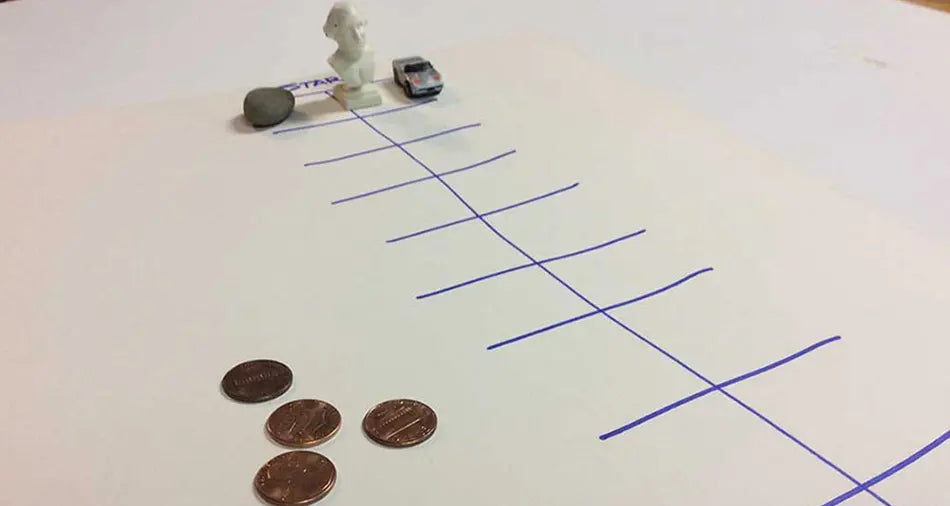Over the years I’ve provided many games workshops for audiences of all ages. In addition, I work with Boy Scouts who wish to earn the Game Design Merit Badge. (Yes, there is one!)
The workshops depend greatly on the audience, the setting, the materials at hand, and the expectations that have been set. So I tailor the content and the process for each session.
I generally start my presentation by trying to establish more of a conversation than a classroom atmosphere. I ask everyone what games they play, what games they like, and what games they “prefer not to play.”
Using a marker board (if one is available), I offer them a little analysis of these games—define the mechanisms they enjoy (or not) and describe others they might enjoy just as much. I help people see beyond the commercial package or colorful licensing, and how to find a game’s roots in the history of play.
With that vocabulary established, it’s time to make a game. I tell the story of sitting down with a group of bored kids at a gathering of some kind. “There’s nothing to do around here” is my favorite starting point. I prove them wrong.
For most workshops, I bring along a kit of components that often raise a few eyebrows: Cowry shells, popsicle sticks, Sharpie markers, bottle caps, and a handful of pebbles, a stick of chalk, maybe a piece of cardboard. (Depending on the setting, I might “plant” some of these components to emphasize their common availability.)
“So, let’s play a game!”
We usually start with a simple race game. We can draw a long line and divide it with cross-hatches into a track of intersections and spaces. Or we can draw a winding circuit of little circles meandering around the page. Or we can create a grid and zig-zag from point to point in some predetermined pattern.
“On this track,” I say, “let’s have a race. Go ahead now, and let me know who wins.”
“But what shall we use for game pieces?” to which I respond, “What do you have in your pockets, or on the ground, that you can use?” Talk about the materials at hand, and what they might represent in our race. (The player? An animal? A rocket? A robot? In the image above, you'll note that it's a race between a sports car, George Washington, and a rock.) Once everyone gets a token, I repeat the challenge: “Go ahead now, and let me know who wins.”
“But how do we know how to move? What shall we use for dice?” This gives me a chance to talk about chance. What are dice, or spinners, or tee-totums, or casting sticks? They are “randomizers”—methods of generating a range of unpredictable results within a certain range. After demonstrating a number of these options (including a deck of cards), I get the players to choose their own methods and materials. (Here's a picture of some randomizers from my collection.)

OK, it’s not rocket surgery, but it’s a start.
Finding meaning
Now we talk about common aspects of games with tracks—spaces that have meanings or consequences. Can these spaces provide decision points instead of random results?
As+D56:F56 the race progresses, can the players interact with each other somehow, to help or hinder? And we talk about each player’s tokens — does each have a special advantage or handicap? These aspects might be randomly assigned or chosen.
In each case, we decide as a group if we add any of these features to the race. And we play a few turns together to see how they work.
Then we talk about themes; If this is a footrace, a car race, a horserace, or a contest between spaceships…how does that affect these choices? If this was a race between superheroes or cartoon characters or historical figures, how would that affect the rules of the game?
The objective is to inspire the group to think about things in a little more depth, and to be a little more analytical. But this is also a way to see how a few simple components can add up to make fun! Simplicity can be added to and embellished to make a game complex. Conversely, complexity in games can be broken down into simpler components.
Given time, we talk about non-race games. As an example, I tell the tale about eating at a favorite restaurant in my youth where they had checkered tablecloths. Yes—that’s a game board! We made up plenty of games with sugar packets and coins while we ate!
All this makes me wonder about the inspiration behind the games people play. What inspired these games, and what mechanisms work together to make them fun?
The possibilities are only limited by your imagination!

